Another Private Tour today. It has to be said, the weather forecast was not ideal, even if it had improved from the worst predictions yesterday and the wind had dropped from yesterday. Still, it was cloudy all day and drizzled during the morning, but it is amazing what you can see if you go looking anyway.
Our first stop was at Cley. We were hoping that conditions might improve a little while we were there, so we walked out along the East Bank. There were lots of Sand Martins hawking for insects over the pools just beyond the car park, and many of them were stopping to perch in the reeds. These birds had almost certainly come here from the local breeding colonies, in an attempt to find somewhere to find food. The female Pochard was still here with her ducklings, although we couldn’t see how many she had today, as they kept tucked in to the edge of the reeds.
Despite the weather, a couple of Sedge Warblers were still singing away and song flighting from the reeds beside the path. We could hear an occasional Reed Warbler singing too.
Looking across to the Serpentine towards Pope’s Marsh, we could see several Lapwings and their chicks still. A Little Ringed Plover flew across and landed out of view on the far edge of the grass and a single Ringed Plover was feeding on the open mud on the edge of the pool.
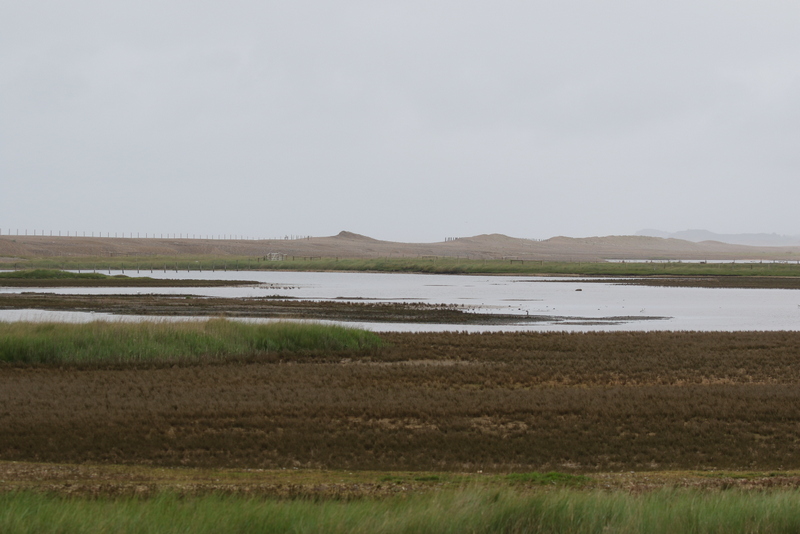 Arnold’s Marsh – looking rather grey this morning
Arnold’s Marsh – looking rather grey this morning
The new shelter overlooking Arnold’s Marsh was very welcome this morning, an opportunity to get out of the light misty drizzle which was falling. There were plenty of Avocets and Redshanks feeding on here as usual. A few more Ringed Plovers were to be found with a bit of looking, on the shingle spits around the edge.
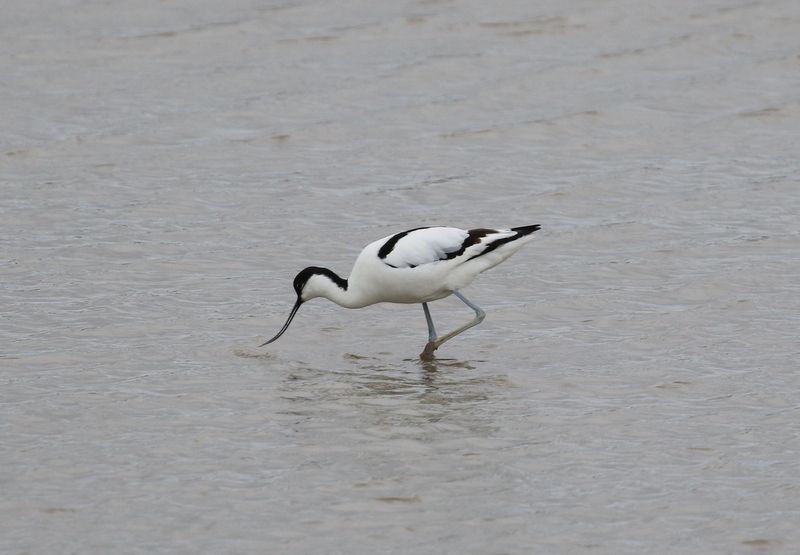 Avocet – feeding on Arnold’s Marsh
Avocet – feeding on Arnold’s Marsh
Over towards the back was a large group of bigger waders, godwits. A quick look through the scope confirmed they were Bar-tailed Godwits. Most appeared to be still in brown non-breeding plumage, so these were possibly younger 1st summer birds. They do not breed in their first year and often remain on the wintering grounds. One smaller male had started to develop rather chestnut-ish underparts, but it was still rather patchy. Hiding in amongst the legs of the Bar-tailed Godwits was a smaller wader, a single Knot, similarly in grey non-breeding plumage.
We had seen a couple of adult Gannets just breaking the horizon over the shingle ridge as we walked out, making their way east, white with prominent black wing tips. So we walked up to have a quick look at the sea. Another Gannet passed by some distance offshore and a Fulmar went through in the other direction, the latter probably a local breeding bird. A Sandwich Tern flew past just offshore.
Otherwise, there was not much happening out here, so we made our way back. As we walked along the bank towards the car, a Bearded Tit flew up from the reedy ditch beside the path and out across the reedbed the other side, a nice bonus and a surprise this morning.
The cloud base appeared to have lifted a little, although this may have been wishful thinking on our part, so we decided to have a go up on the Heath, which was meant to be our primary destination for the morning. We made our way across to where we had seen the family of Dartford Warblers yesterday afternoon. On the way, there were several Willow Warblers still singing despite the weather, and a Blackcap too from deep in the bushes. A couple of Bullfinches were piping to each other from the hedge further over.
There was no sign of the Dartford Warblers initially, but we didn’t stop as we were distracted by a male Stonechat perched on the top of a dead tree and Yellowhammer singing further along, so walked across to have a look at them, intending to swing back this way. Needless to say, there was no sign of the Nightjar on the perch where it had been yesterday – that was clearly going to be a one-off!
A Woodlark appeared above the trees for a split second, unfortunately too brief for everyone to get onto it, and appeared to drop down onto a clear area further back, so we decided to walk over to see if we could find it. On our way, we ran into a couple of other birders who had just seen the Dartford Warblers, flying into exactly the area where we had seen them yesterday. We stopped to see if we could see them too, although again it all seemed rather quiet at first.
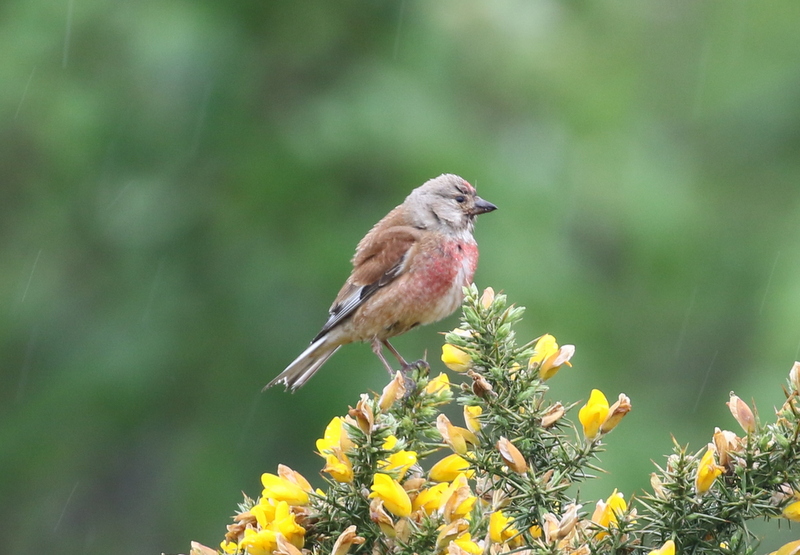 Linnet – a male, singin’ in the rain
Linnet – a male, singin’ in the rain
A male Linnet appeared from the gorse and appeared to be carrying a faecal sack. It perched up nicely on the gorse in front of us, twittering away, and when the female emerged too the two of them flew off a short distance.
Then we glimpsed a Dartford Warbler, a small dark shape zipping low across the heather and diving into cover. Then another glimpse as one shot across in the other direction. With a bit of patience, we could see (and hear) what they were doing. The adults had stashed several juveniles in the gorse and were flying in and out bringing food for them. After a feeding visit, one of the juveniles hopped out into view in front of us, paler, greyer than the adults, still shorter tailed and with a bright yellow gape. The adult Dartford Warblers were mostly keeping down in cover, not a great surprise given the weather, but eventually the male flew in and perched right on top of the gorse in front of us for a few seconds, tail cocked, before disappearing back in. Great stuff!
With good views of Dartford Warbler finally achieved, we walked round to see if we could find the Woodlark. Unfortunately, at this point it started to rain a little harder and there was no sign of it here now. A pair of Stock Doves were feeding out in the clearing. As the rain turned back to drizzle again, we walked back round, stopping on the way to admire a pale male Stonechat perched up on the gorse, with three streaky juveniles hopping about on the low vegetation below, looking for food.
We made our way in a wide circuit round the Heath, in the hope we might bump into another Woodlark on the way, but the vegetation where they like to feed was getting quite wet now. As we were walking along a path, we happened to glance to one side through a gap in the bushes and something caught our eye, a dark shape looked out of place on a much paler stump. Stopping abruptly, we had a quick confirmatory look through binoculars and there in front of us was a stunning Nightjar.
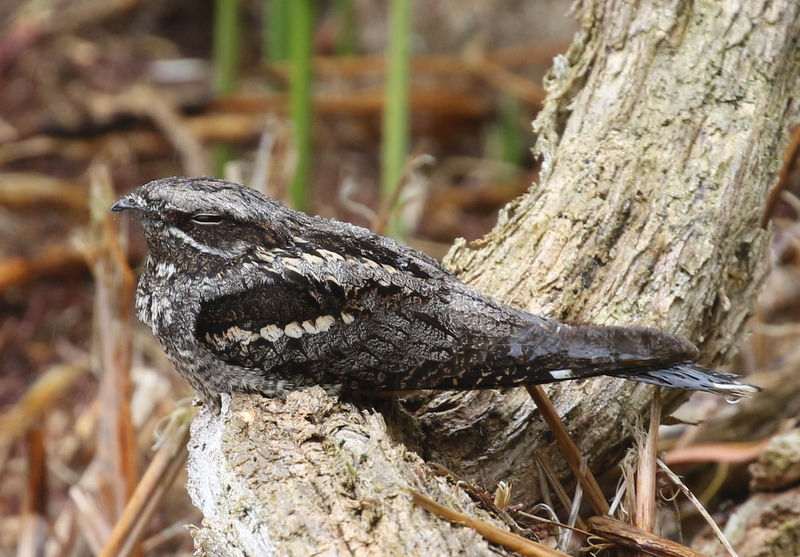 Nightjar – amazing views of another day roosting bird today
Nightjar – amazing views of another day roosting bird today
It is unusual to come across a day roosting Nightjar, so to find two different birds in two days is fairly unprecedented. Still, we weren’t going to complain. We trained the scopes on it for frame-filling views, marvelling at the intricately marked cryptic plumage, even if it wasn’t particularly well camouflaged against the stump on which this one had chosen to rest today. It sat perfectly still, despite the rain dripping off its tail, with only its eyes opening and closing slightly as we watched. Eventually, we had to tear ourselves away and backed off quietly, leaving the Nightjar in peace.
Back to the car, and we dropped back down to the coast and made our way west. We stopped off at the local gull colony next. We could hear the cacophony of noise as we walked up onto the bank. Scanning through the mass of Black-headed Gulls, we could see quite a few Mediterranean Gulls in there too. Their more extensive jet black hoods marked them out instantly from the chocolate brown hoods of the misnamed Black-headed Gulls. Ironically, the latin name of Mediterranean Gull is more accurate, translating as ‘black-headed gull’!
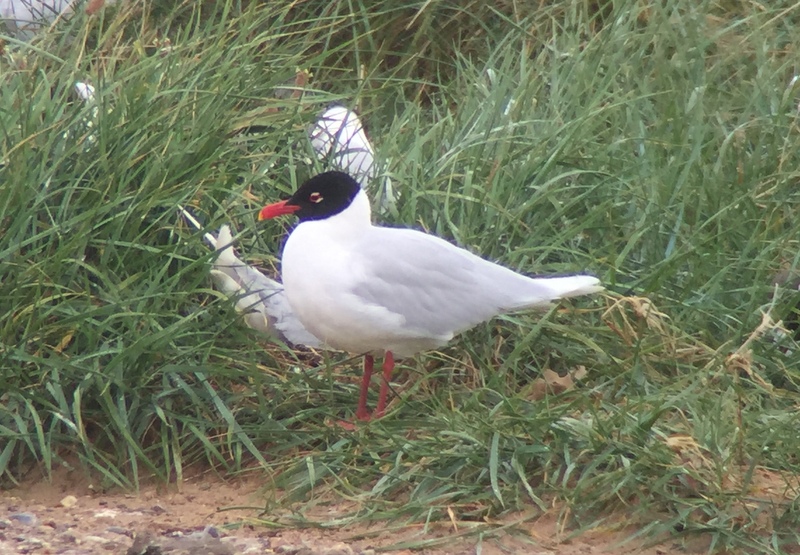 Mediterranean Gull – showing off its jet black hood
Mediterranean Gull – showing off its jet black hood
We could see a smart pair of Common Gulls too, further over, and lots of terns were wheeling round over the colony. Three Sandwich Terns were chasing each other noisily, one of them bearing a gift in the form of a small fish. A couple of Little Terns were fishing over the channel beyond, dwarfed by a nearby Common Tern. Several of the latter were flying in and out carrying fish.
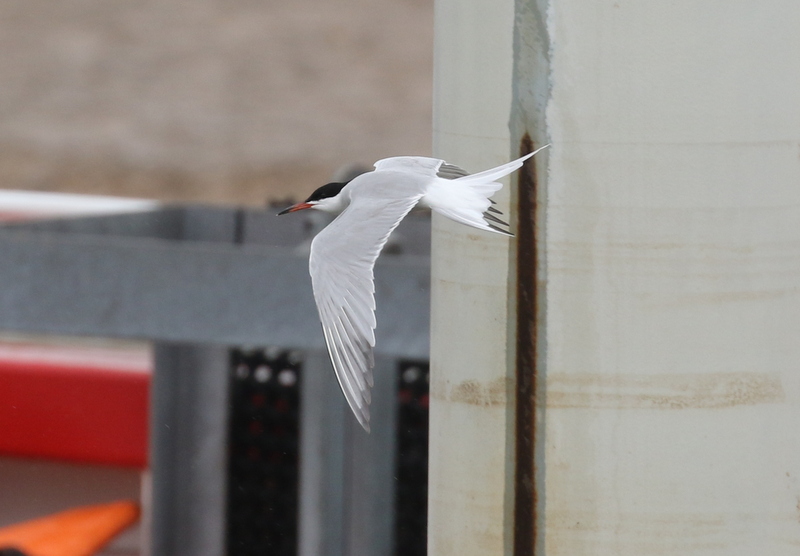 Common Tern – busy fishing in the harbour
Common Tern – busy fishing in the harbour
We walked round to the harbour to see what we could see. The tide was on its way out and there were lots of Oystercatchers on the exposed mud beyond. Scanning through, we found a group of four Curlew too.
Out in the middle of the harbour channel we could see a pair of Great Crested Grebes diving. Then down in a smaller side channel we noticed a white duck diving, a stunning drake Eider. A drake Eider would be a great sight in itself, but this one was fishing actively, diving repeatedly and quickly resurfacing with something each time. Through the scope, we could see that it was actually catching small crabs.
Even better, the Eider seemed to be very cleverly taking the claws off before swallowing them. It would flick the crab round until it was holding it by its legs or claws, then give it a good shake until the leg(s)/claw detached. The body of the crab would drop into the water and it would catch it again quickly before repeating the process. After doing this a few times, it would swallow the dismembered body whole. Fascinating to watch! Eventually the Eider, clearly full of crabs, walked up onto a sandbar nearby.
 Eider – resting after catching crabs in the harbour channel
Eider – resting after catching crabs in the harbour channel
The rest of the afternoon was spent at Holkham. The grazing marshes were full of geese as usual, Greylags and Canada Geese, together with a good scattering of Egyptian Geese. We could see a couple of white shapes in the trees, which on closer inspection could be seen to be Spoonbills. A couple of other Spoonbills flew out east, their long necks and bills held outstretched in front of them, distinguishing them instantly from the steady flow of Little Egrets in and out too.
There were lots of Swifts and House Martins zooming about low over the pools, the best place to look for insects in the cool and cloudy conditions. A male Marsh Harrier appeared from the reeds in front of us and flew slowly round before crashing back in.
We parked at the end of Lady Anne’s Drive, which was unsurprisingly rather empty of cars today, and walked west on the edge of the pines. At least it had stopped drizzling now. The trees were rather quiet, apart from a several Coal Tits calling, plus a Goldcrest or two and a few Chiffchaffs singing. We bumped into one of the wardens who told us that three Bitterns had been seen earlier, flying around out from Washington Hide, so we headed over there first.
We couldn’t see any sign of the Bitterns now, but we did find two Pink-footed Geese out on the grazing marshes. Both appeared to have damaged wings – one was trailing its left and the other had a large gap in the primaries of its right when it flapped.That would explain why these two had not made the journey back to Iceland for the breeding season.
A large group of over 150 Black-tailed Godwits flew up from the marshes at one point, whirling round and flashing their black and white wings and tails before dropping back down out of sight. A female Marsh Harrier flew up from the reeds and circled over, before chasing off a second Marsh Harrier which had drifted into the area.
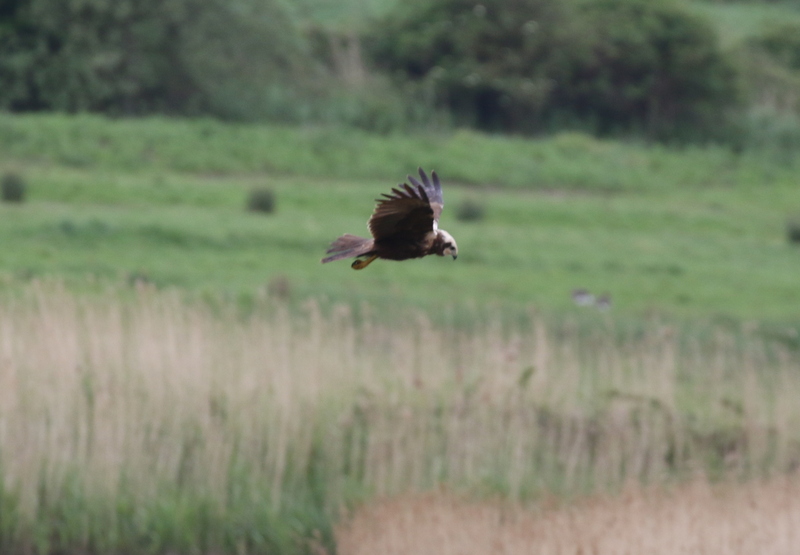 Marsh Harrier – circled up over the reeds
Marsh Harrier – circled up over the reeds
From up in the Joe Jordan Hide, we could see a few Spoonbills circling over the trees from time to time. One landed in the top of the bushes at one point, stopping to preen. Then another Spoonbill appeared on the pool in front. It was feeding, head down, sweeping its bill from side to side through the water. When the flock of Black-tailed Godwits appeared again, clearly flushed from the marshes by something, and swirled round over the pools, the Spoonbill took flight and headed back into the trees.
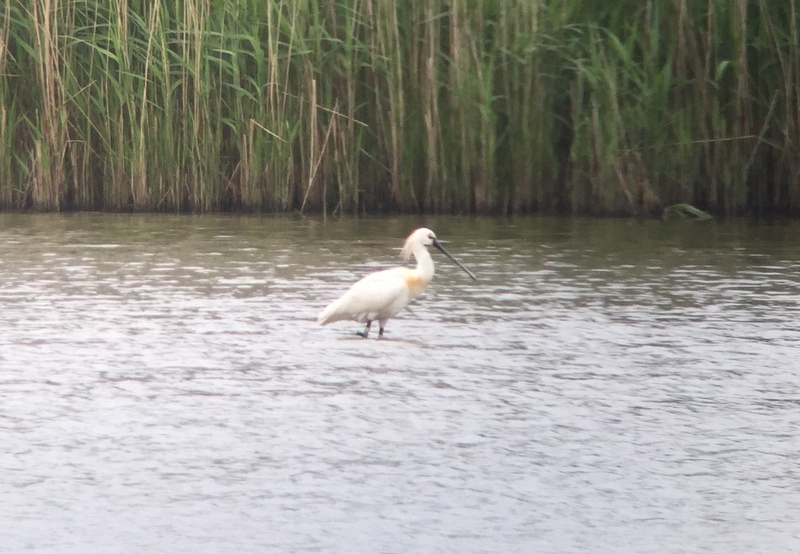 Spoonbill – feeding on the pool from Joe Jordan Hide
Spoonbill – feeding on the pool from Joe Jordan Hide
On the walk back, we found a flock of Long-tailed Tits in the trees by the path. There were several brown-faced juveniles in there, plus a few Blue Tits. A single male Blackcap appeared in the trees too. A Cetti’s Warbler shouted at us from the reeds. Further along, a Sparrowhawk flew low across the path ahead of us, in from the direction of the grazing marshes, and disappeared into the pines.
Then it was time to call it a day. Despite the weather, we had enjoyed a fantastic day’s birding – it just goes to show that it is always worth going out regardless.
















